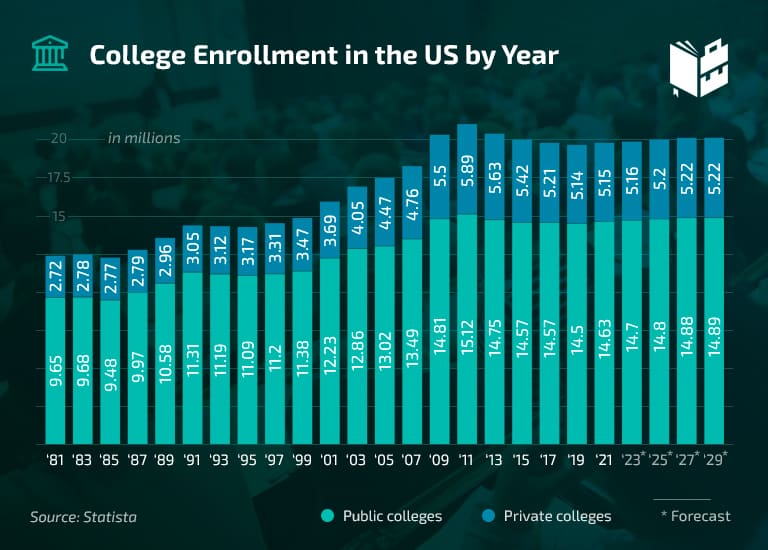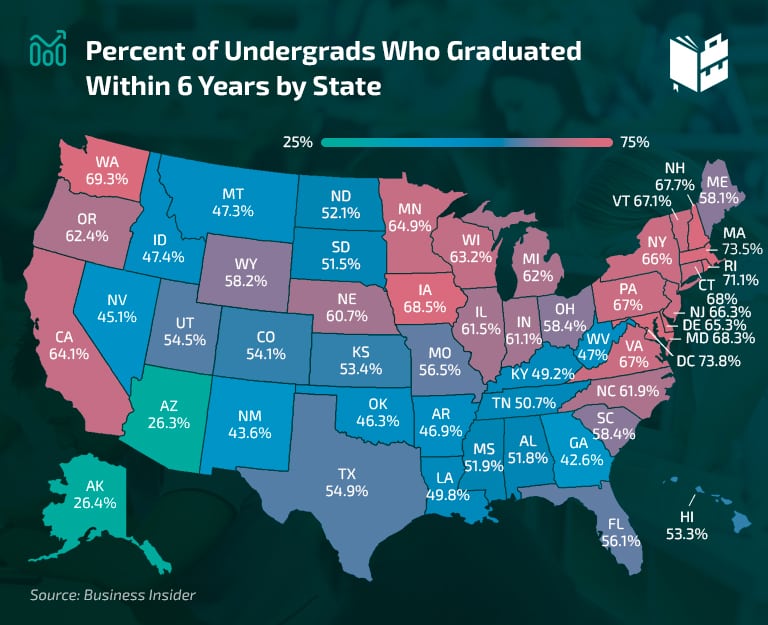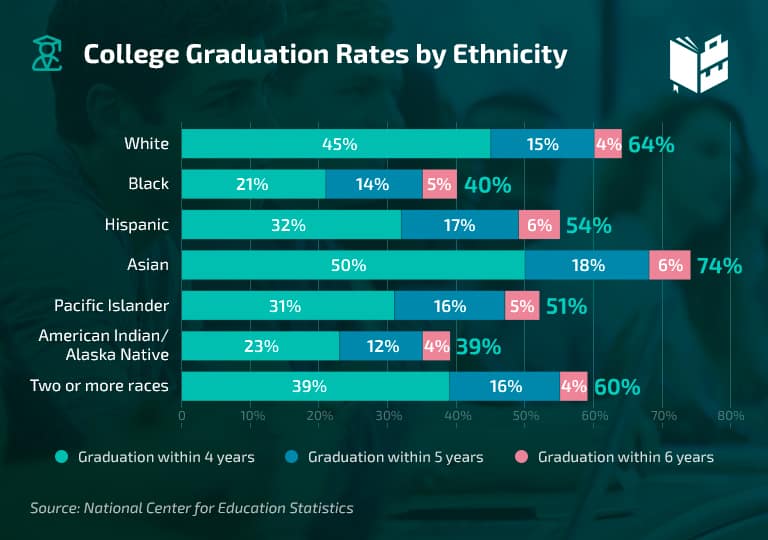The main goal for most new college students is graduation since college graduates are less likely to be unemployed. However, not everyone fulfills this aim. On average, it takes college students nearly six years to earn a bachelor’s degree from a four-year college.
College graduation rates can tell you a lot about public and private institutions, the reasons why students drop out, student graduate demographics, etc.
It’s of the utmost importance to know such information. It can be valuable if you’re a student, graduate, or just thinking about enrolling in college. These stats will certainly help you gain a clear insight into the importance of education and getting a degree.
College Graduation Rate Top Stats and Facts (Editor’s Pick)
- 5.3% of students graduate within eight years.
- The state with the lowest graduation rate is West Virginia.
- The six-year graduation rate for students of public universities and colleges is 69%.
- The percentage of females who graduate in four years is 51%.
- 36% of male Millennials have at least a bachelor’s degree.
- 32.9% of college students drop out before they obtain an undergraduate degree.
- Only 11% of students with low incomes graduate within six years.
- 42% of students take remedial classes within five years after starting college.
Average College Graduation Rates — General Stats
1. The six-year graduation rate for public college starters is 69%.
(NSC Research Center)
There is a steady growth in the graduation rates for two-year and four-year colleges. The NSC Research Center Report shows a 62.2% six-year graduation rate on the national level. The percentage reached 42.2% for the starters at two-year institutions, whereas the four-year starters’ rate increased to 69%.
2. 33.8% of all graduates are underemployed.
(Inside Highered, Statista)
According to one of the latest studies on college graduation rates and employment, 41.1% of recent college graduates are underemployed (which means they work in jobs that don’t require college degrees). Furthermore, almost 34% of all college graduates are underemployed.
3. 5.3% of students graduate within 8 years.
(American Progress)
The Center for American Progress researched graduation rates and discovered some interesting statistics. The new statistics show that an additional 5.3% of college students earn a degree 4 years after the expected graduation time.
4. College pricing for four-year institutions more than doubled over 30 years.
(College Board)
The average graduation price rate for college rose from $4,160 to $10,740 for public four-year institutions between 1991–92 and 2021–22 school years. As for public two-year institutions, the tuition and fees rose from $2,310 to $3,800 for the same period, while the college prices almost doubled for private nonprofit four-year colleges (from $19,360 to $38,070).
5. There will probably be around 20.48 million college students in the US in 2030.
(Statista)
It’s estimated that over 20 million people will enroll in college in 2030. Public colleges have always had more students, as they are much cheaper than private colleges. Approximately 15.1 million students will probably choose to study in a public school, while 5.38 million will attend a private college.

College Graduation Rate by State, School, and Degree
6. West Virginia is the state with the lowest graduation rate.
(World Population Review)
According to the latest data, only 21% of students from West Virginia manage to graduate and obtain a four-year bachelor’s degree. Right after West Virginia is Mississippi with 22% of college graduates.
7. Massachusetts has a 44% graduation rate, the highest in the US.
(World Population Review, US News)
According to the data on college graduation rates by state, Massachusetts has the highest graduation rate and is considered the most educated state in the US. Colorado (41%), Maryland (40%), and New Jersey (40%) come right after Massachusetts.
Some of the prominent colleges include the Massachusetts Institute of Technology, Tufts University, and Harvard.

8. In the 2019–20 school year, 402,669 people received an associate degree in liberal arts and sciences.
(Statista)
College graduation rates at community colleges are the highest for liberal arts and sciences, general studies, and humanities, followed by health professions and similar programs (172,207) and business and management (102,536). On the contrary, only 202 college graduates received a degree in library science.
9. 13% of students enrolled in two-year public institutions graduate within two years.
(Community College Review)
Community college graduation rates are relatively low. Only approximately 22% of students of such institutions graduate after three years, and around 28% of students do so after four years.
10. The six-year graduation rate stands at 46.4% at four-year private for-profit institutions.
(NSC Research Center)
According to the NSC Research Center Report, 46.4% of students graduate after six years at four-year private for-profit institutions. In addition, only 8.5% of students enrolled at four-year private for-profit institutions had dual enrollments before starting.
11. The University of Notre Dame has a four-year graduation rate of 93%.
(US News)
Graduation rates by college show that the University of Notre Dame holds the highest graduation rate. Other universities with high graduation rates are Babson College (92%), Bowdoin College, Swarthmore College, University of Chicago, and Washington and Lee University (91%).
12. Southern University at New Orleans has a four-year graduation rate of 1%.
(US News)
This college had the lowest proportion of four-year graduates. West Liberty University, Georgia Gwinnett College, Medgar Evers College — CUNY, Sul Ross State University, and Universidad Politecnica de Puerto Rico have four-year graduation rates lower than 5%.
College Graduation Rates by Race, Age, Gender, and Ethnicity
13. 51% of women graduate in four years.
(Best Colleges)
There is a noticeable difference in graduation rate when broken up by gender. The percentage of women who graduate within four years is 51%, and the graduation rate for men is 41%.
Experts who compared the rates are worried that there is a growing gender gap. However, the five-year and six-year graduation rates begin to close that gap.
14. The graduation rate for Black students at four-year nonprofit colleges is 51.3%.
(NSC Research Center)
Black students’ college graduation rates are worryingly low. A recent report shows that only 51.3% of black students graduate within six years from four-year public nonprofit colleges, while those who attend a private nonprofit institution graduate at a rate of 57.4%. On the other hand, both figures are noticeably higher than the average graduation rate for black students (43%).

15. 37.5% of Hispanic students graduate after four years.
(NCES)
Hispanic, Black, and Native American students have the lowest graduation rates. These statistics show that there’s still a considerable cultural and racial gap in American society. Hispanic college graduation rates after six years of studying are only 58.7%.
16. 77% of Asian/Pacific Islander students graduate within six years.
(NCES)
Asians are the most likely to graduate from public four-year colleges, as 55.3% do so within four years, while 77% graduate after six. White students are the second on this list, as 67.4% of them graduate in six years, and 51.2% obtain a degree within four.
17. Only 8% of Millennials have less than a high school diploma.
(Pew Research)
College graduation rate research by Pew Research Center targeted a population of different ages and showed that Millennials are the generation with the highest rate of college graduates (39%). 28% have some college education, while a quarter of Millennials possess a high school diploma. What’s more, 90% of low-income first-generation college students don’t graduate within six years.
18. 36% of Millennial men have at least a bachelor’s degree.
(Pew Research)
Millennials are better educated than the generations before them. Also, Generation X women are the first to outpace men when education is in question. Furthermore, 43% of Millennial women have at least a bachelor’s degree.
19. Females of all ethnicities from the 2014 entry cohort had higher graduation rates than males.
(NCES)
College graduation rates by gender are the same for every ethnicity: female students are more likely to graduate than male students. The number of female students who graduated within four years from the 2014 entry cohort was 51.3%, while only 41% of males from the same entry cohort obtained a degree.
20. Students with low family incomes are 79.3% more likely to drop out of college.
(Education Data)
College students whose family incomes are in the lowest quarter have a 79.3% higher chance of leaving college than those in the top quarter. Meanwhile, the college dropout rates are also high for those who are between 35 and 64 years old.
Other Relevant and Interesting Stats on US College Graduation Rate
21. 32.9% of college students give up before obtaining an undergraduate degree.
(Education Data, Affordable Colleges Online)
Most of these college dropouts leave school after their first year. The main factors for leaving school are balancing work and family, expensive tuition, and challenging courses. However, students can always choose to go back to college and finish it.
22. 11% of low-income students graduate within six years.
(iGrad Financial Wellness)
Various statistics reveal that low-income students’ college graduation rates are high, especially for minorities. On top of that, almost 40% of such students have to take student loans. Many college dropouts struggle to pay off student loan debts for the rest of their lives.
23. 30% of community college students successfully transferred to a four-year college.
(Hechinger Report)
Many students choose community colleges because they think they are cheaper. However, four-year institutions often offer more aid than community colleges. Also, only 30% of community college students managed to transfer to a four-year institution. College graduation rates over time haven’t changed much for community colleges.
24. College graduates who start college at the age of 18 most often graduate when they’re 23.
(College Economics)
Students who enroll in college at the age of 18 usually graduate when they’re 23. However, the average graduation age for students who start college when they’re 24 or older is around 32.
25. The NCAA Division I graduation rates were 90% in 2021.
(NCAA)
According to a study by the NCAA, college athletes’ graduation rate maintained its record rate in 2021. Meanwhile, Division II graduation rates stood at 76% (a 1% increase from 2020), and Division III at 88% (2% higher than 2020).
26. 42% of college starters take remedial college classes within five years.
(NCES)
Two out of five college starters from the 2011–12 beginning year took remedial college classes by 2017. During this period, the students took three remedial courses and passed two on average.
Data on college remediation rates revealed that this process only decreases the college completion rate. It increases the time it takes for them to attain a degree, thereby reducing their likelihood of graduating.
College Graduation Rates — Conclusion
Statistics like these are crucial because they help us know the performance level of a school. When considering which institution to attend, the first thing you will have to look at is its graduation rate.
A low number is usually a bad sign. However, although statistics are vital information, they shouldn’t be the only thing to consult before making your final choice. At the end of the day, the most important thing is to choose to study something that genuinely interests you.